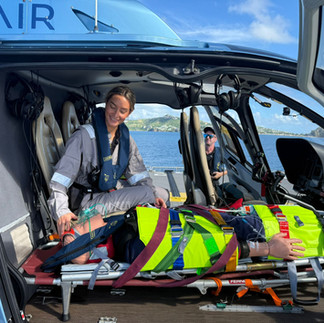The Importance of Drills
- Rachel Smith

- Sep 10
- 4 min read
“Malcolm Gladwell is quoted to have said that you have to have 10,000 hours practice in a subject to become an expert”
Hmmm, that’s great to know, and there is definitely evidence to back up the theory that the more you practice, the better you get! But what about keeping your medical skills up to date when it’s just a small part of your role, and a part that you secretly hope is rarely or never needed?

Drills (or just practice) involves a repetitive exercise designed to teach or perfect a skill or procedure. Drills can build confidence by breaking down complex actions into smaller, repeatable steps, which make the skill easier to acquire and master over time. They also help to build up muscle memory, which is the ability to reproduce a particular movement without conscious thought, acquired as a result of frequent repetition of that movement.The technique of repeating a specific action or problem many times means the skill becomes ingrained, allowing for more confident and autonomous execution. Drills are widely used across sport, music, medicine and the emergency services.
In the maritime world, we frequently drill scenarios such as a fire onboard, or man overboard, because it’s a requirement. But it’s easy to become complacent and the drill can turn into a ‘tick box’ exercise, with crew standing around wondering what’s for lunch, rather than concentrating and imagining what would be happening in a real situation.
We always think it’s quite ironic that those with the most medical training onboard (unless there is a healthcare professional such as a Nurse or Paramedic) are the ones who will be busiest keeping the ship safe if there is an emergency, or making sure a medevac is correctly organised. As one newly appointed nurse on a ferry told us, her job was created because the Captain and Staff Captain spent years training to manage the vessel, not to deal with an unwell passenger. In a medical situation, they have other jobs to do!
We also have the challenge of not always working with the same team. Rotations rotate and crew come and go each season and over the years, so it makes it even more important to drill with different teams and scenarios. You might find that the greenest Stewardess is actually really good at communicating with the patient, or the engineer is a great team leader and stays calm in an emergency. Or the other way round!Let’s say you’d like to design a few medical scenarios to put your crew through their paces. How do you plan a drill, and how on earth do you measure success, especially if you’re not a medic?
Firstly you need to define your objectives, as this is what you will measure against later. Then create a potential scenario. What do you want to test? Is there already a procedure for it? You could consider managing a situation where the most medically trained person onboard is incapacitated, or moving an immobilised casualty from one part of the vessel to another. Is time important - the time getting to the patient, getting the kit assembled, or bringing a defibrillator? If you’re doing a required drill, can you tag on a medical scenario at the end, such as managing a hypothermic MOB, or a crew member suffering from smoke inhalation or heat stroke.
Whatever scenario and objectives you choose, the crew need to be informed and clear about expectations.
If you have a subscription to a telemedicine company, speak to them about getting involved. They’re normally very willing to take a call and assist with a drill - giving you vital information about how to contact them and the timeframes involved, plus the details they will need from you.
Assign roles and challenge people. Hidden skills and abilities may be uncovered and it’s good to remember that ego’s should always be left at the door where medicine is concerned.
At the end of the drill, all involved need to be objective in their feedback and remember that this is training. The purpose is to improve, and a great question to ask at the end is ‘if you could do this drill again right now, what would you do differently?’.
Some training may involve exactly that, where the drill is completed and reviewed, then done again straight away to reinforce what was learnt. Or the first run through is in slow time, followed by a real time drill.
There are many tools available to guide a debrief, but whichever you choose, it is important to get everyone together to discuss what happened. A hot debrief tool that we recommend is the STOP5 Hot Debrief Model.
STOP5 has been adopted in many healthcare settings for a quick debrief after an incident. The idea is to STOP for just 5 minutes and it works like this:
Firstly thank the team and ask ‘Is everyone OK?’ – remember you’re likely to just get a yes from everyone at this stage.
Tell them it’s a 5 minute debrief – to improve the quality of xxx (insert your own outcome here, such as to improve ship safety), it is not a blaming session.
Participation is welcome, but not compulsory and any information discussed during the debrief is confidential.
Summarise the case/drill/scenario
Things that went well
Opportunities to improve
Points to action and responsibilities
It’s also worth remembering that medical scenarios in particular can trigger emotions and memories, so it’s worth checking in with the participants a couple of days later too.
We hope you’ve found this blog useful, and if you’d like any advice or guidance about creating and running a drill, just get in touch or take a look through our blogs for inspiration. Please let us know about the drills you use onboard and if any are particularly useful.
















Comments